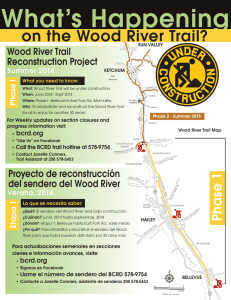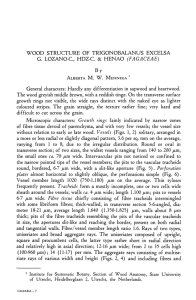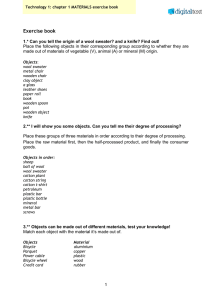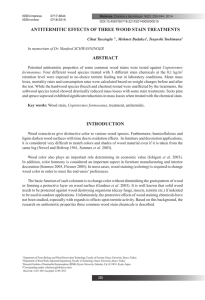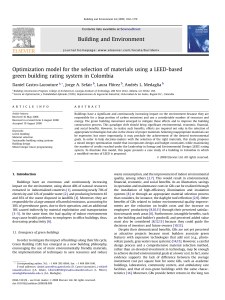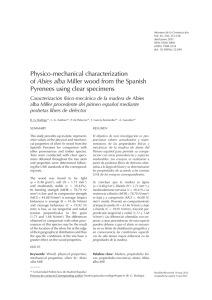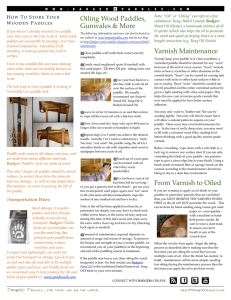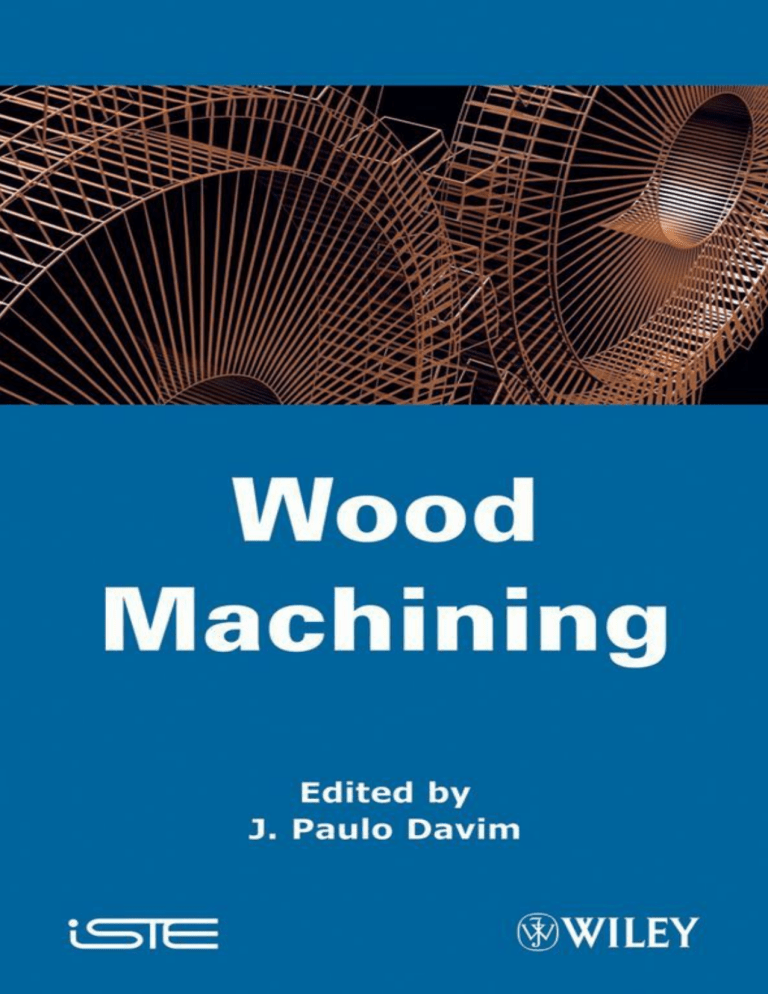
Table of Contents Preface Chapter 1. Machining of Wood and Wood Composites 1.1. Introduction 1.2. Wood and wood-based composites 1.3. Approach to cutting 1.4. Main techniques of machining 1.5. Problems of machining wood and wood composites – a review 1.6. Into the future – further scenarios of wood and wood composites machining 1.7. Acknowledgement 1.8. Bibliography Chapter 2. Wood and Wood-based Panel Machining Quality 2.1. Solid wood machining 2.2. Wood-based panel machining 2.3. Surface quality 2.4. Case study: solid wood machining and surface quality evaluation 2.5. Case study: particleboard machining and edge quality evaluation 2.6. Bibliography Chapter 3. Reducing Tool Wear by Cryogenic Treatment and Cooling with Refrigerated Air when Processing Medium Density Fiberboard 3.1. Introduction 3.2. Effects of refrigerated air 3.3. Effects of cryogenic treatment and refrigerated air 3.4. Acknowledgements 3.5. Bibliography Chapter 4. Wearing Mechanisms Contributing to Reduced Tool Life after Wood and Secondary Wood Products Machining 4.1. Introduction 4.2. Cutting edge-material cut interface 4.3. TGA indirect evidence of HTTR 4.4. Theoretical QC analysis of HTTR 4.5. Investigations of direct evidence of HTTR 4.6. Cutting edge SEM image examinations 4.7. Synergistic effect of high temperature reactions and mechanical wear 4.8. Final remarks 4.9. Conclusions 4.10. Acknowledgements 4.11. Bibliography Chapter 5. Monitoring Surface Quality on Molding and Sawing Processes for Solid Wood and Wood Panels 5.1. Introduction 5.2. General concepts 5.3. Monitoring the cutting process 5.4. Surface roughness and quality for solid wood and panels 5.5. Concluding remarks 5.6. Acknowledgements 5.7. Bibliography Chapter 6. Evaluating the Roughness of Sanded Wood Surfaces 6.1. Introduction 6.2. Profile filtering applied to wood surfaces 6.3. A proposed method for separating processing roughness from anatomical roughness 6.4. A case study: the processing roughness of oak surfaces sanded with various grit sizes 6.5. Concluding remarks 6.6. Perspectives 6.7. Acknowledgements 6.8. Bibliography List of Authors Index First published 2011 in Great Britain and the United States by ISTE Ltd and John Wiley & Sons, Inc. Apart from any fair dealing for the purposes of research or private study, or criticism or review, as permitted under the Copyright, Designs and Patents Act 1988, this publication may only be reproduced, stored or transmitted, in any form or by any means, with the prior permission in writing of the publishers, or in the case of reprographic reproduction in accordance with the terms and licenses issued by the CLA. Enquiries concerning reproduction outside these terms should be sent to the publishers at the undermentioned address: ISTE Ltd 27–37 St George's Road London SW19 4EU UK www.iste.co.uk John Wiley & Sons, Inc. 111 River Street Hoboken, NJ 07030 USA www.wiley.com © ISTE Ltd 2011 The rights of J. Paulo Davim to be identified as the author of this work have been asserted by him in accordance with the Copyright, Designs and Patents Act 1988. Library of Congress Cataloging-in-Publication Data Wood machining / edited by J. Paulo Davim. p. cm. Includes bibliographical references and index. ISBN 978–1-84821-315-9 1. Millwork (Woodwork) 2. Woodworking machinery. I. Davim, J. Paulo. TS878.W66 2011 674--dc23 2011014037 British Library Cataloguing-in-Publication Data A CIP record for this book is available from the British Library ISBN 978–1-84821-315-9 Preface In general, wood as an engineering material can be technically defined “as a hygroscopic, orthotropic, biological, and permeable material having extreme chemical diversity and physical complexity, with structures that vary extensively in their shape, size, properties and function”. Therefore, using wood to its best advantage and most efficiency in engineering applications, specific characteristics or chemical, physical and mechanical properties must be considered. It is usual to divide the products into two classes, solid wood and composite wood products. Solid wood includes, for example, applications in furniture and cabinets, shipbuilding, bridges, flooring, mine timbers and posts. Composite wood products include, for example, insulation board, plywood, oriented strand board, hard-board and particle board. In recent years the machining of wood products has acquired great importance due to the short supply of wood and increasing environmental awareness among users and manufacturers. The optimization of the machining process is around the chip formation, tool wear, workpiece surface quality, crack initiation and propagation of different types of wood. Other factors are also taken into consideration such as humidity, temperature, static preloads, and vibrations that can affect the wood during the machining process. The purpose of this book is to present a collection of examples illustrating the state of the art and research developments in the machining of wood and wood products. Chapter 1 presents the fundamentals of machining of wood and wood composites. Chapter 2 covers wood and woodbased panels’ machining quality. Chapter 3 contains information on reducing tool wear by cryogenic treatment and cooling with refrigerated air when processing medium density fiberboard. Chapter 4 is dedicated to wearing mechanisms contributing to tool life decrease by machining wood and secondary wood products. Chapter 5 covers monitoring surface quality on molding and sawing processes for solid wood and wood panels. Finally, in Chapter 6, evaluating the roughness of sanded wood surfaces is presented. This book can be used as a research book for a final undergraduate engineering course (for example, wood, mechanical, materials, manufacturing, etc.) or as a subject on machining of wood and wood products at the postgraduate level. This book can also serve as a useful reference for academics, wood researchers, mechanical, manufacturing and materials engineers, professionals in areas related to the manufacturing of wood and wood products. The interest of this book is evident for many important research centers, laboratories and universities throughout the world. Therefore, it is hoped that this book will encourage and enthuse other research in this important field of engineering and technology. I would like to extend my gratitude to ISTE-Wiley for this opportunity and for their professional support. Finally, I would like to thank all the chapter authors for their availability to work on this project. J. Paulo DAVIM University of Aveiro Portugal May 2011 Chapter 1 Machining of Wood and Wood Composites 1 1.1. Introduction While machining of wood has been conducted for many centuries, and significant progress has been made in the cutting of wood, the shape of the tool – wedge – has not changed. With the progress of the new tool materials, more abrasion resistant and durable blades are being introduced to machining. The rapid development of composite wood products also causes the improvement of the techniques and machines used to process such materials. New theories regarding cutting help with better utilization of raw materials. Computerized control of the machines makes it easier to achieve the assumed quality and productivity. 1.2. Wood and wood-based composites Although wood is well known to all of us, a compact characterization of this material can be useful before starting the analysis of wood machining aspects. Chemical composition of wood, depends, among other things, on its species, it is based on cellulose (about 45–55%), lignin (about 25–30%), hemicelluloses (10–20%), resins, rubbers (4.5–9.5%) and mineral contamination (about 0.5%). Because of the significantly higher share of cellulose and lignin only those two components are described below. Cellulose, polysaccharide with a crystalline structure, is the main component of the cell wall structure. The molecules of cellulose are bonded together in long chains creating elongated fibers – micelles. In the free spaces between the bunches of micelles the lignin and water are stored. Cellulose is not water and alcohol soluble, and can be extracted from the cell wall only in an acid environment. Lignin is an amorphous material, which fills the frame of the cell wall, and is fixed with cellulose mechanically and chemically. The presence of lignin makes the cell walls harder and stiffer. In the macroscopic structure of wood the following elements can be found: – pith; – growth rings; – sapwood; – heartwood; – rays; – resin canals. Figure 1.1. Cross-section of softwood (in this case Pinus Silvestris L.) The pith is the physiological axis of the tree and is situated in the central part of the crosssection of the stem. The shape of the pith is characteristic of the tree species: star-shaped for oak, quadrangle for ash, triangular for alder. Growth rings are the effect of the annual accumulation of the wood layer. Two areas can be found in the structure of growth rings: earlywood and latewood. The earlywood is lighter and is created during spring. The main function of this part of the growth ring is transportation. The anatomical elements of this part have thinner walls and larger dimensions, compared to the latewood. Latewood, which is darker, is created during summer and because of the mechanical functions has thicker walls. The softwood species have a larger earlywood area, and the latewood area mostly has a constant width. Hence, when the width of the growth rings increases, the density of wood decreases. In the case of hardwood species, mostly ring-porous, the width of the latewood increases with the increase of the growth ring width. The variation of the growth ring width gives information about the climatic conditions during creation of those rings. The width of the growth rings depends on weather, climate and soil parameters, as well as on specific biological features of the species. The width of the growth rings varies between 1 and 40 mm and depends on the temperature and vegetation period length. It means that the same species, e.g. from the mountain biotope can have narrow growth rings, whereas trees from the lowland habitat have wide growth rings. Sapwood is a biologically active zone which transports water and nutrients along the trunk. Heartwood does not take part in transportation, because the vessels are plugged and the walls of the vessels are impregnated with resins, rubbers and tannins. The formation of heartwood depends on the tree age (e.g. 20–30 years for pine, 60 years for ash), soil and climate. Rays are the complex of the cells, which accumulate and transport water with mineral salts inside the trunk. Resin canals are thin tubes, which run along and across the trunk producing resin. The structure of wood, which consists of elongated anatomical elements, influences its anisotropy, this means that the physical and mechanical properties differ in the three principal directions relative to the trunk of the tree. The type of wood is one of the main factors, which has a great effect upon the machining. There are two major types of wood: softwood from needle-bearing trees, and hardwood from broadleaved trees. The descriptions “soft” and “hard” have little to do with the hardness and density of wood. Figure 1.2. Principal directions when cutting wood: II – longitudinal, # - tangential and ⊥ radial The wood-based composite materials can be classified by the size of wood parts used to produce them. According to this, the following products can be found: – plywood; – OSB (oriented stradboard); – particleboard; – fiberboard. Plywood is build up of thin sheets (plies) of wood (veneer), which are bonded together with glue under pressure. Plywood is produced mostly as flat panels or pre-shaped elements for furniture production. Plywood can be produced from either softwoods and hardwoods. To achieve improved dimensional stability of plywood panels, they are usually constructed with an odd number of layers with the grain direction of adjacent layers oriented perpendicular to one another. This gives plywood fairly similar axial strength and stiffness properties in perpendicular directions within the panel plane. From the utilization point of view, two types of plywood are produced: construction and decorative. The production of structural engineered materials, e.g. Ijoists, is the other use for plywood. The main technique of plywood processing is sawing. Oriented strandboard (OSB) is the structural-use panel produced from thin wood (most often softwood) strands bonded with resin. Because of the strands' typical aspect ratio (strand length divided by width) of about 3, and the special orientation of the strands in the panel's layers, the OSB panel has a greater bending strength in the oriented directions. OSB panels are used mostly for roof, wall, and floor sheathing in wooden and prefabricated constructions, as well as for the elements in I-beams. Utilized as flat panels elements the OSB panels are mainly machined by sawing. Typical furniture particle panel is produced in three layers. The core layer is made of the coarser material, which improves raw material utilization. Face layers, from the fine particles, give a smooth surface for laminating, overlaying or painting. The chips are bonded together mostly with amine resins, as urea-formaldehyde resin. Figure 1.3. The mechanical forming head of the particleboard layer To improve the short-term moisture resistance of panels, paraffin or microcrystalline wax emulsion is added. Blended particles are pressed under elevated temperature and pressure. After pressing, the panel surfaces are sanded and can be finished and may also be veneered or overlaid with other materials to provide a decorative surface. The main ways of processing particleboards are circular sawing, milling (routing) and drilling. The main difference between two types of fiberboard, hardboard and medium-densityfiberboard (MDF) is the method of mat formation: wet-method, where the fibers are moved in the water suspension and pressed with no bonding agent addition for hardboards; or the mat is formed by the pneumatic-mechanical method for MDF. The natural tendency of the lignocellulosic fibers to create larger conglomerates is utilized to produce hardboard. During production of MDF, the fibers are blended with resin (mostly amine). The dry-formed group of panels, in addition to MDF, include high density fiberboard (HDF) and low density fiberboard (LDF). The main application of HDF panels are flooring materials, while LDF panels are used as wall facing. The furniture industry is by far the dominant MDF market, where it is frequently used in place of solid wood. The more regular structure of MDF panels across the thickness (compared to particleboards, for example) gives the opportunity for deep routing (milling) of the faces and shaping of the edges for the furniture fronts or doors. Sawing, milling, drilling, as well as deep routing are the most common ways of machining fiberboards. 1.3. Approach to cutting Part of the tool, where the cutting is conducted, has a triangular shape. When the width of the machined material is smaller than the length of the cutting edge, free cutting is realized. In such a case only one cutting edge works. An example of free cutting is planing. If the width of the machined material is more than the length of the cutting edge, cleft cutting occurs. Apart from the main cutting edge, two side edges also work. An example of such cutting is sawing. A combination of the two abovementioned cutting methods is also possible: if the main cutting edge and one side cutting edge works. This situation often takes place during milling of wood. Figure 1.4. Simplified cutting process model According to Huang et al. [HUA 00], cutting work, when cutting with an elementary knife (flat cutting), can be divided into two components: the work of new surface creation (work of fracture) and the work of chip deformation (see Figure 1.2). Cutting work can be calculated as follows: [1.1] where E is the cutting work [J], FC is the cutting force [N], and l is the cutting path [m]. When the abovementioned cutting work is referred to the cut surface, the specific cutting work can be calculated: End of this sample Kindle book. Enjoyed the sample? Buy Now or See details for this book in the Kindle Store
